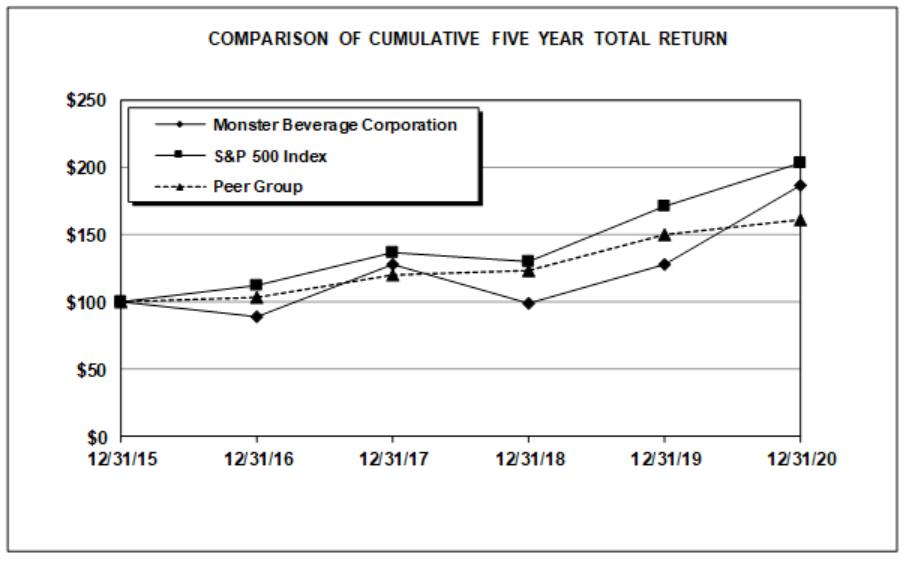Intellectual Property
We presently have more than 14,200 registered trademarks and pending applications in various countries worldwide, and we apply for new trademarks on an ongoing basis. We regard our trademarks, service marks, copyrights, domain names, trade dress and other intellectual property as very important to our business. We consider Monster®, Monster Energy®,  ®, Monster Energy Ultra®, Monster Dragon Tea®, Unleash the Beast!®, Mutant®, Monster Rehab®, Java Monster®, Muscle Monster®, Punch Monster®, Juice Monster®,
®, Monster Energy Ultra®, Monster Dragon Tea®, Unleash the Beast!®, Mutant®, Monster Rehab®, Java Monster®, Muscle Monster®, Punch Monster®, Juice Monster®,  Hydro® (stylized), Monster HydroSport Super Fuel®, Monster Super Fuel®, Espresso Monster®, Monster MAXX®, Reign Total Body Fuel®, Reign Inferno®, BU®, Nalu®, NOS®, Full Throttle®, Burn®, Mother®, Ultra Energy®, Play® and Power Play® (stylized), Relentless®, Predator®, Fury®, Live+® and BPM® to be our core trademarks. We also own the intellectual property of our most important flavors for certain of our Monster Energy® Brand energy drinks in perpetuity.
Hydro® (stylized), Monster HydroSport Super Fuel®, Monster Super Fuel®, Espresso Monster®, Monster MAXX®, Reign Total Body Fuel®, Reign Inferno®, BU®, Nalu®, NOS®, Full Throttle®, Burn®, Mother®, Ultra Energy®, Play® and Power Play® (stylized), Relentless®, Predator®, Fury®, Live+® and BPM® to be our core trademarks. We also own the intellectual property of our most important flavors for certain of our Monster Energy® Brand energy drinks in perpetuity.
We have registered Monster®, Monster Energy®,  ®, Monster Energy Ultra®, Unleash the Beast!®, Mutant®, Monster Rehab®, Java Monster®, Muscle Monster®, Punch Monster®, Juice Monster®, M Hydro®, Espresso Monster®, Monster MAXX®, BU®, Nalu®, Burn®, Mother®, Play®, Power Play® (stylized), Relentless®, Ultra Energy®, BPM®, Predator®, Fury®, Live+®, Reign®, Reign Total Body Fuel® and Reign Inferno® outside of the United States in certain jurisdictions.
®, Monster Energy Ultra®, Unleash the Beast!®, Mutant®, Monster Rehab®, Java Monster®, Muscle Monster®, Punch Monster®, Juice Monster®, M Hydro®, Espresso Monster®, Monster MAXX®, BU®, Nalu®, Burn®, Mother®, Play®, Power Play® (stylized), Relentless®, Ultra Energy®, BPM®, Predator®, Fury®, Live+®, Reign®, Reign Total Body Fuel® and Reign Inferno® outside of the United States in certain jurisdictions.
We protect our trademarks by applying for registrations and registering our trademarks with the United States Patent and Trademark Office and with government agencies in other countries around the world, particularly where our products are distributed and sold. We assert copyright ownership of the statements, graphics and content appearing on the packaging of our products and in our marketing materials. We aggressively pursue individuals and/or entities seeking to profit from the unauthorized use of our trademarks and copyrights, including, without limitation, wholesalers, street vendors, retailers, online auction site sellers and website operators. In addition to initiating civil actions against these individuals and entities, we work with law enforcement officials where appropriate.
Depending upon the jurisdiction, trademarks are valid as long as they are in use and/or their registrations are properly maintained and they have not been found to have become generic. Registrations of trademarks can generally be renewed as long as the trademarks are in use.
We also enforce and protect our trademark rights against third parties infringing or disparaging our trademarks by opposing registration of conflicting trademarks and initiating litigation as necessary.
Government Regulation
The production, distribution and sale in the United States of many of our products are subject to various U.S. federal, state and local regulations, including but not limited to: the Federal Food, Drug and Cosmetic Act (“FD&C Act”); the Occupational Safety and Health Act and various state laws and regulations governing workplace health and safety; various environmental statutes; the Safe Drinking Water and Toxic Enforcement Act of 1986 (“California Proposition 65”) and a number of other federal, state and local statutes and regulations applicable to the production, transportation, sale, safety, advertising, marketing, labeling and ingredients of such products. Outside the United States, the production, distribution and sale of many of our products are also subject to numerous statutes and regulations.
We also may in the future be affected by other existing, proposed and potential future regulations or regulatory actions, including those described below, any of which could adversely affect our business, financial condition and results of operations. See “Part I, Item 1A – Risk Factors – Changes in government regulation, or failure to comply with existing regulations, could adversely affect our business, financial condition and results of operations” below for additional information.
14
